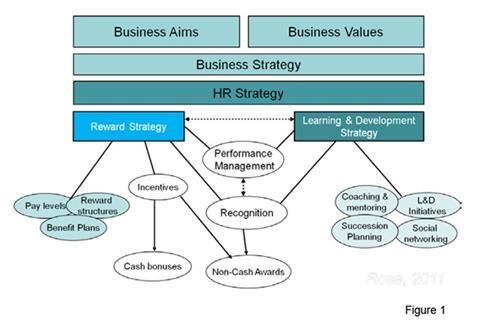Valuable insights can come from unexpected sources. For example, in Lewis Caroll’s Alice’s Adventures in Wonderland we have the following discussion between Alice and the Cheshire cat: Alice: ‘Would you tell me, please, which way I ought to go from here?’ The cat: ‘That depends a good deal on where you want to get to.’ Alice: ‘I don’t much care where.’ The cat: ‘Then it doesn’t matter which way you go.’ Alice: ‘…so long as I get SOMEWHERE.’ The cat: ‘Oh, you’re sure to do that if you only walk long enough.’
The point for us is pretty obvious. We need to have a sense of direction to enable us to develop reward strategies that are relevant, meaningful and will help the organisation. A sense of direction also helps us filter the opportunities that we come across which are likely to support or hinder our progress.
In Reward management, 5th edition, published in 2007, authors Michael Armstrong and Helen Murlis note the importance of direction as an element in a reward strategy: “Reward strategy determines the direction in which reward management innovations and developments should go to support the business strategy, how they should be integrated, the priority that should be given to initiatives and the pace at which they should be implemented.”
The short hand definition I mostly use is that reward strategy is an approach to reward based on a set of coherent principles in support of the organisation’s aims.
In Reward strategies: from intent to impact, published in 2001, author and principal at Aon Hewitt, Duncan Brown, says: ‘…reward strategy is ultimately a way of thinking that you can apply to any reward issue arising in your organisation, to see how you can create value from it.’
I think one can take some or a combination of these points and define what reward strategy means for your own organisation. But whatever definition you decide on, it is important to see reward strategy squarely in the context of the organisation’s strategy and overall HR strategy.
Holistic links
Although reward is seen as one of the most technical HR disciplines, it will fail badly if not embedded as part of an holistic approach to HR. In particular, I see a strong connection between reward and learning and development.This is reflected in figure 1 (below) taken from my last book, A guide to non-cash reward, published in 2011.

The particular strategy you employ will be influenced by many internal and external factors. But one of the strongest internal factors may be the belief system on the role of reward. Figure 2 (below) illustrates the nature of the continuum of beliefs. Where you sit on the continuum will affect the reward policies you employ and how you see their relationship with other factors that engage people at work.

Whether you see reward as being very proactive or neutral, the reward practices you employ will carry messages. They are likely to carry much stronger messages than any other part of the employee deal. As professor Shaun Tyson says in Human Resource Strategy: towards a general theory of human resource management, published in 1995: “Monetary rewards may not motivate in the long term, but they certainly symbolise the value corporations attach to specific behaviours - for example rewarding long service, interpreted as loyalty, or rewarding performance above other attributes.”
Timing
The nature of reward is that much of it runs on an annual cycle (financial year, annual pay review, annual bonus etc). This means that if you miss making a change at the right time in the cycle, you have to wait another whole year. But often you need to take a long term view and, based on the sense of direction, may need to make changes over two or even three years. This is not just a practical issue, but may be needed to carry with you the key stakeholders.
Of course, whilst the strategy might move you neatly in a particular direction at an ideal pace, both may be influenced by internal factors (changing priorities, budgets, management readiness etc) and external factors (economic, legal, markets etc). Any of these can, and are likely to, throw you off course. That is just the real world we live in. It must not, however, put you off developing a reward strategy. It is the reward strategy that will help you determine the best approach in light of the inevitable changes along the way.
Key questions
To help develop a reward strategy, it is valuable to challenge the organisation by asking some very simple questions such as:
- What are each of the different elements of reward for?
- What messages do our reward programmes carry?
- Are the messages they carry in conflict?
- How cost effective are our reward programmes?
- What is the perceived value of reward programmes in the eyes of employees?
- How do they fit with our values?
- What should be the same, and what can be different? (particularly useful for international organisations)
If you can drive down to a clear answer to each of these questions, you will have a solid foundation on which to build your reward strategy.
This article has been reproduced with persmission of Michael Rose author of ‘A guide to non-cash reward’.






























